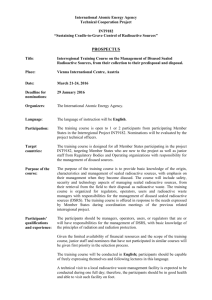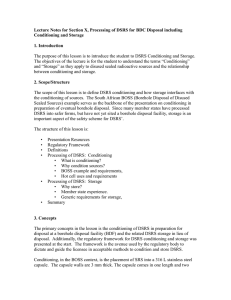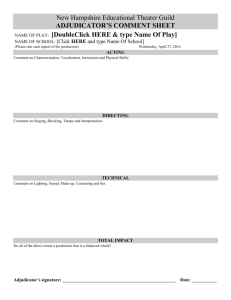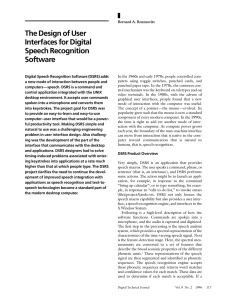TUN Comments_on_SC_JR_CRAFT
advertisement
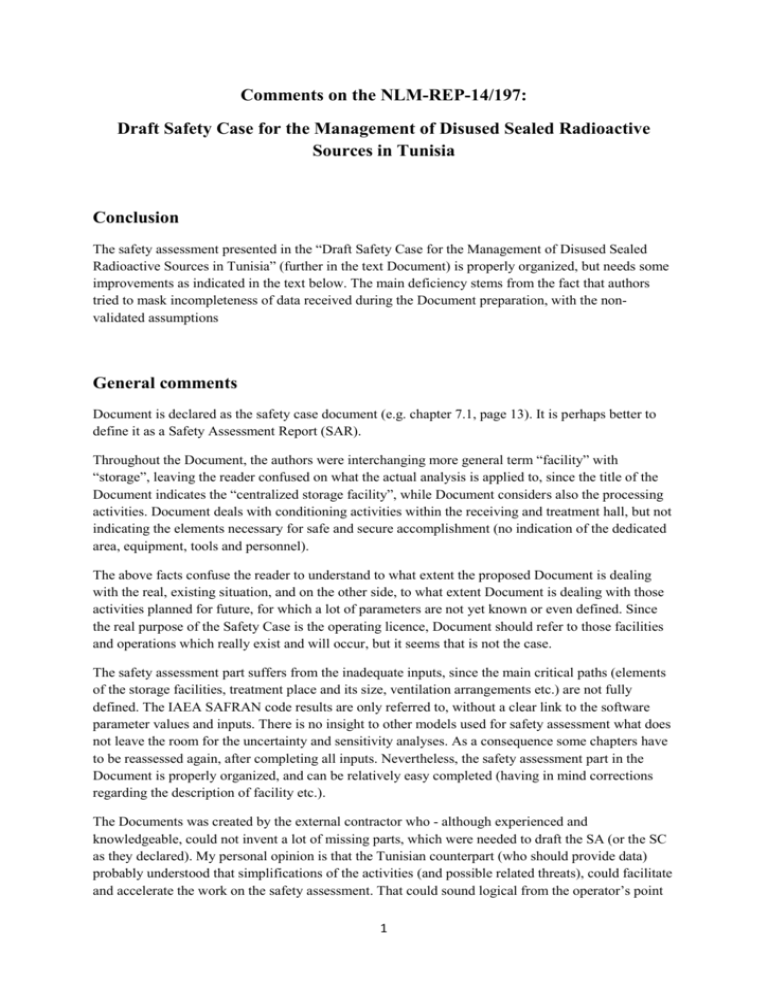
Comments on the NLM-REP-14/197: Draft Safety Case for the Management of Disused Sealed Radioactive Sources in Tunisia Conclusion The safety assessment presented in the “Draft Safety Case for the Management of Disused Sealed Radioactive Sources in Tunisia” (further in the text Document) is properly organized, but needs some improvements as indicated in the text below. The main deficiency stems from the fact that authors tried to mask incompleteness of data received during the Document preparation, with the nonvalidated assumptions General comments Document is declared as the safety case document (e.g. chapter 7.1, page 13). It is perhaps better to define it as a Safety Assessment Report (SAR). Throughout the Document, the authors were interchanging more general term “facility” with “storage”, leaving the reader confused on what the actual analysis is applied to, since the title of the Document indicates the “centralized storage facility”, while Document considers also the processing activities. Document deals with conditioning activities within the receiving and treatment hall, but not indicating the elements necessary for safe and secure accomplishment (no indication of the dedicated area, equipment, tools and personnel). The above facts confuse the reader to understand to what extent the proposed Document is dealing with the real, existing situation, and on the other side, to what extent Document is dealing with those activities planned for future, for which a lot of parameters are not yet known or even defined. Since the real purpose of the Safety Case is the operating licence, Document should refer to those facilities and operations which really exist and will occur, but it seems that is not the case. The safety assessment part suffers from the inadequate inputs, since the main critical paths (elements of the storage facilities, treatment place and its size, ventilation arrangements etc.) are not fully defined. The IAEA SAFRAN code results are only referred to, without a clear link to the software parameter values and inputs. There is no insight to other models used for safety assessment what does not leave the room for the uncertainty and sensitivity analyses. As a consequence some chapters have to be reassessed again, after completing all inputs. Nevertheless, the safety assessment part in the Document is properly organized, and can be relatively easy completed (having in mind corrections regarding the description of facility etc.). The Documents was created by the external contractor who - although experienced and knowledgeable, could not invent a lot of missing parts, which were needed to draft the SA (or the SC as they declared). My personal opinion is that the Tunisian counterpart (who should provide data) probably understood that simplifications of the activities (and possible related threats), could facilitate and accelerate the work on the safety assessment. That could sound logical from the operator’s point 1 of view, but can also cause significant oversimplifications, and finally lead to the incompleteness of the Document. For that, one cannot blame the NECSA only, since they did their homework according to the inputs given by their counterpart in Tunisia. Finally one could - as a lesson learned - conclude that in such cases (when the SA is performed by the TSO from the other country) an additional auditing is needed after completing the work. Specific comments The Scope The scope of the Document includes “DSRS management activities” what differs from the title, since “management activities” besides the storage include also characterization and conditioning (including re/packaging etc.). If all mentioned WM activities are to be accessed, the scenarios have to be developed with a clear indication of the place (what is not done), including all safety elements which could be involved in the normal and/or accidental scenarios, and with clear allocation of responsibilities. Page 14, Scope of the Safety Case: Conditioning of the DSRS and further long term storage. Handling and placement into final storage. Conditioning of the DSRS is an activity which requires dedicated area/facility, with additional requirements regarding the shielding, ventilation, equipment, staff etc. Such an area, which could be declared as a kind of “hot cell” or something similar, was not included in the short description of the facility (see Figure 2: Waste Treatment and Storage Facility Layout, and Figure 3: Proposed Radiological Area Classification of Facility). The only place in the Document where the treatment area was described is the name attached to the Figures 2 and 3, with a common name “Receiving and treatment hall”. It is therefore not clear where these activities were planned within receiving and treatment hall. If the mobile hot cell is planned – e.g. outside the facility, or within the hall, that should be pointed out in the Document. The Purpose The purpose includes the following specific aspects which are addressed on page 13: i) Demonstration of the safety of the proposed CNSTN Waste Management Facility Comment: This is an extension regarding the title. Is it justified? ii) Demonstration of the safety of various proposed radioactive waste management activities that will be performed by CNSTN. These activities include collection at user’s facilities, transport of DSRS to the CNSTN Waste Management facility, receiving and characterization of the DSRS, temporary storage and conditioning and longer term storage. 2 Comment: According to this item, Document will also consider activities conducted by the CNSTN outside of the facility and the site – i.e. “collection at user’s facilities, transport of DSRS to the CNSTN Waste Management facility” etc. iii) Optimization of the respective waste management activities described above. Comment: According to the title, Document deals with the storage of DSRS. However, following the previous item, Document will consider also collection at user’s facilities, transport of DSRS, characterization, and conditioning of DSRS. Optimization of these activities was neither defined, nor performed. iv) Management systems implemented in support and to ensure the safety of the respective waste management activities described above. Comment: See above. Demonstration of Safety Paragraph 7.3.1 Basic Engineering Analysis The missing total capacity of the Storage facility will be assessed later, so also missing wall thickness at this stage of the Document should be not an issue. However, some statements do not correspond with the real situation as it is. For example, the Paragraph 7.3.1 Basic Engineering Analysis, page 15 Physical delineation of areas designed for storage and for the main waste management operations are isolated, this way it is ensured the appropriated segregation of materials optimizing worker’s exposure during operations. Comment: First, there is no “physical delineation of areas designated for storage and for the main waste management operations” - because these areas are not defined – at least not on the figures presented in the Document. Second – what are “the main waste management operations” – characterization, conditioning, storage – or altogether. The third: what is the difference in the text between the radioactive waste and DSRS? Each delineated area has a sufficient physical space that ensures a minimal probability of accident occurrence during waste management operations and package handling. Comment: See above. Unconditioned radioactive sources are stored in storage systems ensuring normal operation and minimizing probability of accidents. Comment: What are the “storage systems” for unconditioned radioactive sources, and where they are on the layout figure? There is a vault with special shielding structure that minimizes worker’s exposure for the storage of sources of greater or unknown activity that could have not been conditioned. Comment: What is the “special shielding structure” (where is this on the figures), and where is that vault, how deep is it and what protection it is enabling? Storage building areas were designed under the principle of labyrinth, which contributes to optimize the exposure of workers. (Stored DSRS and waste operations are not in taking place in the same area). Comment: The above statement is taken from the chapter 7.3 Demonstration of safety/7.3.1 Basic Engineering Analysis. However, later on, in the table 10.1 on page 35, item 2.5, there is a 3 statement under “Compliance”: No labyrinth system. Only a wall placed in front of entrance to storage room to reduce radiation shine from storage area. Graded approach On page 17 authors said “The only time that bare DSRS will be handled during normal operational conditions in any DSRS management facility is during source conditioning operations”, indicating that the “risk is reduced by performing the work in accordance with specific works procedures” and “permanent radiation protection controls in place”. There is however no any further evidence – neither regarding the specific procedures, nor the permanent radiation protection in place. There is another document (NLM-SUR-00079) which in general deals what is needed for general radiation protection issues, but not targeting the specific radiation exposures in the facility (e.g. internal exposures, etc.). Safety assessment Safety assessment endpoints Dose to public not assessed. The facility is far from any human colony. Nevertheless, within the suite there are different institutions, with (unknown) number of employees, which cannot be considered as operators. Justification is needed. Development of scenarios Scenarios are properly structured, for both normal and accidental situations. However, they are not presented and discussed in a transparent and visible way. The results are given in tables, without providing the insight to the models and assumptions used. Due to the fact that conditioning is not fully defined, the scenarios and related assessment should be taken conditionally (facility not defined, activity only in general). In addition, the environmental assessment is considered qualitatively only. Results of IAEA code SAFRAN are given, but with no further reference (SAFRAN version, inputs and assumptions). Recommendations It is necessary to revisit some chapters and improve some details according to the comments given above. Five days mission involving NECSSA experts is recommended to accomplish this task. 22.10.2014. Jagos Raicevic NSRW, IAEA 4

